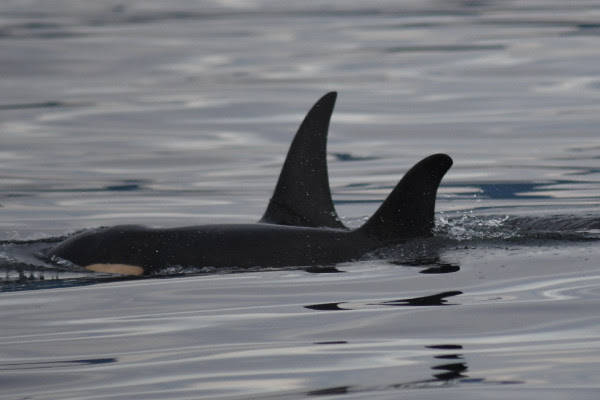Submitted by the Center for Whale Research
As of Sept. 19, another Southern resident killer whale, J-52, — a 2 and a half-year-old male born during the so-called “baby boom” of 2015-16 — is deceased, presumably from malnutrition.
His nursing ended more than a year ago, and his life was dependent upon salmon that have become in short supply this summer.
He was last seen alive near the west entrance of the Strait of Juan de Fuca on Sept. 15, and photographs taken at the time reveal severe “peanut-head” syndrome associated with impending death.
Young J-52 was accompanied by his mother (17 and a half-year-old, J-36) and an adult male (26-year-old L-85, potentially his father) at least five miles away from the other members of J and L pods that were foraging within a mile or two of the coastline from Camper Creek to Bonilla Point, west of Port Renfrew, British Columbia.
The observation of this event was at sunset, and the young whale appeared very lethargic while barely surfacing as the two adults were swimming around in circles and not feeding while attentive to the young whale. The center’s staff estimated J-52 was within hours, if not minutes, of death at the time, and he was not present during the J pod foray into Puget Sound on Sept. 19, though his mother and L-85 were. The mother did not appear overly emaciated on either occasion, but she is lean and seems distressed. These animals exhibit emotion and death of an offspring brings it on.
All of the Southern resident killer whales, observed this summer, appeared skinny and small compared to the transient killer whales in the Salish Sea that have abundant prey resources (seals and other marine mammals). Timing of food availability is everything, especially in critical phases of growth or gestation.
With the passing of J-52, three of the six whales born in J pod during the baby boom, which began in December 2014 with the birth of J-50, have now died; and, two mothers (J-14, J-28) and a great-grandmother (J-2) in the pod have also died.
No Southern resident killer whales from any of the pods have been born alive and survived thus far in 2017 – the baby boom is over.
This population cannot survive without food year-round; individuals metabolize their toxic blubber and body fats when they do not get enough to eat to sustain their bodies and their babies.
All indications (population number, foraging spread, days of occurrence in the Salish Sea, body condition, and live birth rate/neonate survival) are pointing toward a predator population that is prey limited and non-viable. Their population-sustaining prey species is Chinook salmon, but resource managers hope that they find something else to eat for survival.
The government systems steeped in short-term competing financial motives are processing these whales and the salmon on which they depend to extinction. If something isn’t done to enhance their prey availability almost immediately (it takes a few years for a Chinook salmon to mature and reproduce, and it takes about twelve years for a female orca to mature and reproduce), extinction of this charismatic resident population of killer whales is inevitable in the calculable future. Most analyses show functional extinction as a result of no viable reproduction within decades to a century with current predator/prey trajectories, but it can happen more quickly than that.
For more information on the Center for Whale Research, visit www.whaleresearch.com.




